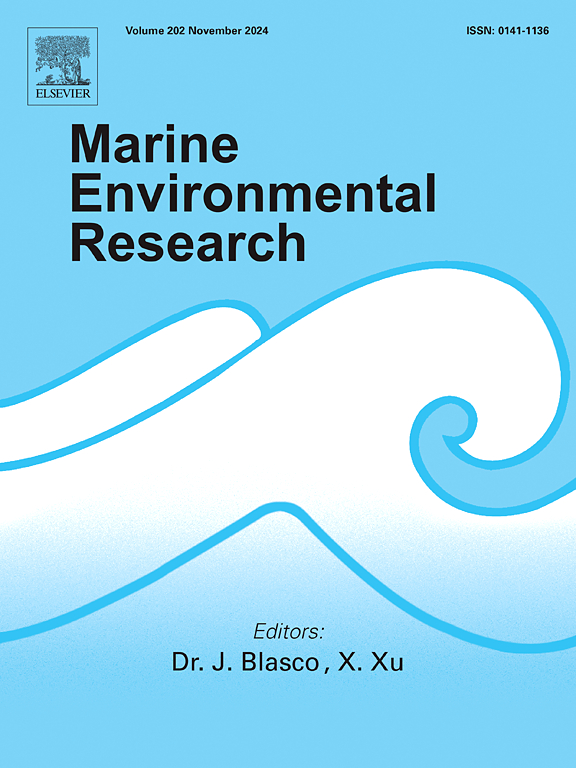Unprecedented high-temperature triggers a rapid shift in ecological characteristics of phytoplankton succession in the southern coastal waters of Korea
IF 3.2
3区 环境科学与生态学
Q2 ENVIRONMENTAL SCIENCES
引用次数: 0
Abstract
Marine heatwaves (MHWs) are increasing in frequency and intensity worldwide, significantly impacting marine ecosystems. However, studies on phytoplankton community changes in coastal waters under such conditions remain. In the summer of 2024, an extreme high-temperature event (>28 °C) occurred in the southern coastal waters of Korea, providing an opportunity to investigate phytoplankton community dynamics under thermal stress. Biweekly depth-specific monitoring at 5 m intervals during this period revealed that diatoms maintained high biomass in the mid-to-bottom layers, where temperatures were relatively lower and nutrient concentrations were higher. In contrast, phytoplankton biomass and photosynthetic efficiency declined in the surface layer, with this decline becoming more pronounced as the heatwave intensified. Furthermore, Margalefidinium polykrikoides, a species historically responsible for harmful algal blooms (HABs) in the southern coastal waters of Korea during summer, failed to survive in the surface layer and was observed only in low abundances at depths of 5–10 m. Meanwhile, Synechococcus exhibited a significant increase under high-temperature, low-salinity, and oligotrophic conditions. These findings suggest that climate change may alter HAB dynamics while also increasing the role of small phytoplankton in primary production. Following typhoon-induced water column mixing, phytoplankton biomass partially recovered, with diatoms playing a central role in this recovery. Recurrent marine heatwaves are likely to favor heat-tolerant species while reducing the abundance of large diatoms, which form the foundation of the coastal food web. Such structural changes could have cascading effects on the marine food web, ultimately impacting the stability of the marine ecosystem.

前所未有的高温引发了韩国南部沿海浮游植物演替生态特征的快速变化
全球海洋热浪的频率和强度都在增加,对海洋生态系统产生了重大影响。然而,在这种条件下,对沿海水域浮游植物群落变化的研究仍然存在。2024年夏季,韩国南部沿海水域发生了一次极端高温事件(>28°C),为研究热胁迫下浮游植物群落动态提供了机会。在此期间,每隔5 m进行双周深度监测,发现硅藻在温度相对较低、营养物质浓度较高的中下层保持较高的生物量。相比之下,表层浮游植物生物量和光合效率下降,随着热浪的加剧,这种下降更加明显。此外,历史上造成夏季韩国南部沿海有害藻华(HABs)的Margalefidinium polykrikoides未能在表层存活,仅在5-10米深处观察到低丰度。同时,在高温、低盐度和少营养条件下,聚珠球菌数量显著增加。这些发现表明,气候变化可能会改变HAB动态,同时也会增加小型浮游植物在初级生产中的作用。在台风引起的水柱混合后,浮游植物生物量部分恢复,硅藻在这种恢复中起着核心作用。反复出现的海洋热浪可能有利于耐热物种,同时减少构成沿海食物网基础的大型硅藻的丰度。这种结构变化可能对海洋食物网产生级联效应,最终影响海洋生态系统的稳定性。
本文章由计算机程序翻译,如有差异,请以英文原文为准。
求助全文
约1分钟内获得全文
求助全文
来源期刊

Marine environmental research
环境科学-毒理学
CiteScore
5.90
自引率
3.00%
发文量
217
审稿时长
46 days
期刊介绍:
Marine Environmental Research publishes original research papers on chemical, physical, and biological interactions in the oceans and coastal waters. The journal serves as a forum for new information on biology, chemistry, and toxicology and syntheses that advance understanding of marine environmental processes.
Submission of multidisciplinary studies is encouraged. Studies that utilize experimental approaches to clarify the roles of anthropogenic and natural causes of changes in marine ecosystems are especially welcome, as are those studies that represent new developments of a theoretical or conceptual aspect of marine science. All papers published in this journal are reviewed by qualified peers prior to acceptance and publication. Examples of topics considered to be appropriate for the journal include, but are not limited to, the following:
– The extent, persistence, and consequences of change and the recovery from such change in natural marine systems
– The biochemical, physiological, and ecological consequences of contaminants to marine organisms and ecosystems
– The biogeochemistry of naturally occurring and anthropogenic substances
– Models that describe and predict the above processes
– Monitoring studies, to the extent that their results provide new information on functional processes
– Methodological papers describing improved quantitative techniques for the marine sciences.
 求助内容:
求助内容: 应助结果提醒方式:
应助结果提醒方式:


